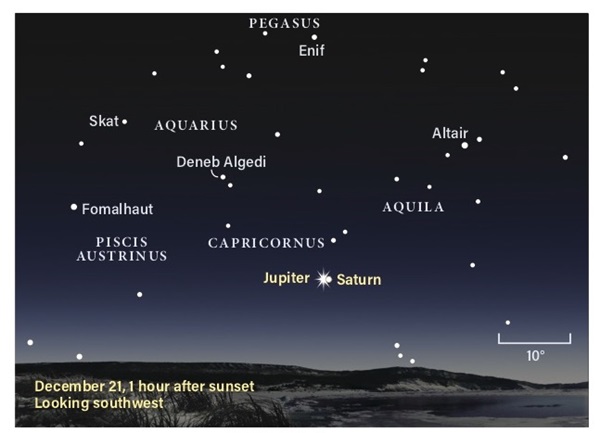Key Takeaways:
On the very day of the winter solstice, Saturn comes as close to Jupiter as Jove’s own moons. And, unlike previous conjunctions, this one’s not obscured by solar glare.
The astrological world will go nuts. From time immemorial, a meeting of Jupiter and Saturn has been considered the most auspicious of them all — the only such planetary meeting called a Great Conjunction. It’s the rarest type of conjunction between any of the five bright planets, with an incidence just once every two decades.
Jupiter-Saturn meetings have been traditionally viewed with alarm, with numerous purported earthly effects, none of them good. Of course, astronomers disbelieve in such occultist stuff and your friend Bob, living near Woodstock, New York, with its high concentration of astrologers, tries to do his part to help it sink into the oblivion it deserves. In a radio broadcast, for example, I debated the editor of the Larousse Encyclopedia of Astrology. And, after a neighbor complained that she wasn’t feeling good because “Mercury is in retrograde,” your columnist replied with, “Do you know how ridiculous that sounds?” I’d wanted her, at least this once, to hear negative feedback after saying that kind of thing. More realistically, she probably merely concluded that her neighbor Bob is obnoxious.
Astrologically, a Great Conjunction happening precisely on the solstice will probably elevate the event to DEFCON 1. Of course, astronomers know that while the two gas giants appear separated by less than a single degree, one lies twice as far away as the other, so they’re really nowhere near each other at all. Still, for sheer spectacle, we’ll see the planets closely meet in Capricornus while separated from the Sun sufficiently to be easily observed in the fading twilight.
Some in the media will likely claim the planets will merge and appear as a single super-bright “star.” This may indeed be true for those who skipped their last eye exam. But those with normal vision will perceive two close-together “stars” — a gorgeous, eye-catching sight most of us have never seen in our entire lives.
Through our telescopes using low to medium power, those two largest worlds will appear in the same field — an unforgettable experience. It should be more impressive than a Mercury transit or a total lunar eclipse, and compete with a great comet in terms of spectacle. But be aware that Saturn’s direction from Jupiter will be at right angles to the jovian moon system. So, while the ringed planet will appear to come as close to Jupiter as its satellite Callisto regularly does, it will be off in a different direction.
Some important viewing tips: Make sure hills, trees, or houses won’t block your view of these planets, which are lowish in the southwest. Venture out a few evenings before the conjunction to be sure the planets will be in the clear. If not, find a place that shows them and plan to be there half an hour after sunset on the 21st.
Know what eyepiece you’ll use to place both worlds in the same field. You’ll never again get this chance! That’s not hype. Two factors can elevate the event to amazing instead of merely interesting: whether the planets are separated enough from the Sun to be out of solar glare, and how closely they approach each other. The Great Conjunction of February 1961 was the nearest runner-up to this month’s event, but the pair was lower and deeper in glare. Their Great Conjunction of December 1980 didn’t bring these planets as close together; this was also the case during the May 2000 Great Conjunction. The next one in October 2040 will not be very good at all, with the planets farther apart and also in glare. And in October 2060, the planets again won’t be too close together.
So now is the time. Let’s hope for clear skies on that day when the seasons change, marking the solstice of this very strange year.










